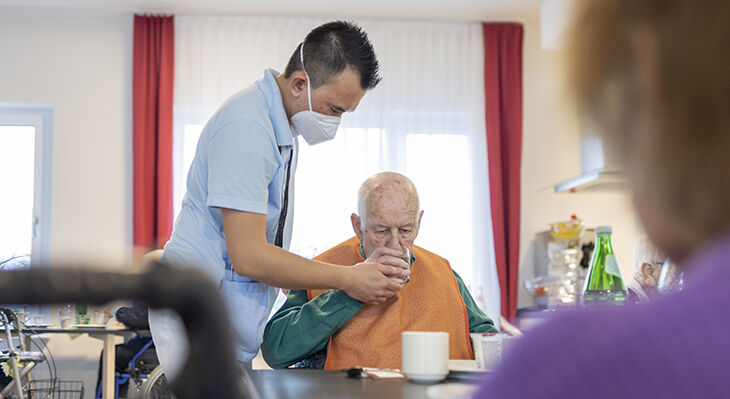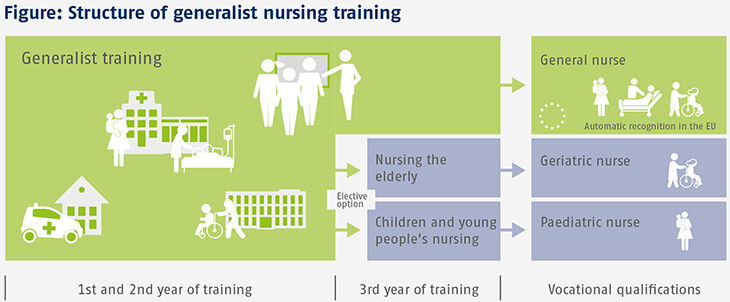Profile of an occupation – general nurse
The occupational profile of “general nurse” was introduced in 2020 to bring together the fields of geriatric nursing, general nursing and paediatric nursing with the aim of increasing the quality and attractiveness of nursing training. Those completing this generalist training programme are qualified to care for persons of all ages. New medical modules offered at the end of nursing training allow expanded competencies to be acquired.

A broad area of deployment and activity
People nowadays are living longer and then often present various disease patterns at the same time in old age. This means that the tasks and requirements of nursing have become more complex and more diverse. Nursing also extends across different areas of care, and these are covered during training. Nursing trainees complete placements in hospitals, at care facilities, in outpatient care services, in psychiatric care and in care for children and young people. General nurses take on tasks which are aimed at maintaining, fostering, restoring or improving a person’s physical and mental state. These include everything from the planning of nursing processes to taking action in acute situations such as emergencies. General nurses have a broad area of deployment and activity and they are able to gather numerous experiences with patients across all age groups. Training is free of charge, and there is also an entitlement to receive an appropriate training allowance. Completion of the generalist training programme leads to the vocational qualification of “general nurse”. General nurses work in all areas of in-patient and out-patient care, such as in hospitals or old people’s homes. They may also find employment at institutions for children and young people or in district nursing. Trainees may either proceed to the end of generalist training or, after two thirds of the programme, choose instead to pursue the training objective of becoming a “geriatric nurse” or a “paediatric nurse”. In such a case, the final year of training will be specially geared towards the relevant age group for which they will be caring (cf. Figure). As of the cut-off date of 31.12.2021, there were a total of 105,000 trainees in the new nursing professions. 61,458 trainees commenced their training in 2021 (7% more than the previous year). Almost three quarters (45,750) of these are female.
Medical modules
The Nursing Professions Act also makes provision for expanded training leading to the acquisition of competencies which will allow responsibility to be assumed for medical tasks. The plan in future is for additional modules (each of a duration of between 120 and 400 hours) to be offered and trialled within the scope of pilot projects at nursing schools and training institutions. Training will be extended accordingly in such instances. Each federal state will run a pilot project enabling general nurses to acquire new competencies that will allow them to take autonomous charge of medical tasks in certain areas of care. Depending on the alignment of the pilot project, they will then make decisions regarding the care and treatment processes of persons suffering from the following conditions.
- Diabetes mellitus
- Chronic wounds
- Pain
- High blood pressure
- Dementia
- Diseases of the respiratory tract
- Problems with nutrition and excretion
Expanded training will also be open to persons who have already obtained authorisation to practise in a nursing profession governed by federal law.
Special term – “reserved tasks”
Reserved tasks are specifically defined activities which may only be performed by persons who are qualified in a certain profession. It is therefore forbidden for such tasks to be assigned to or carried out by anyone else. The specific legislation governing nursing stipulates that only general nurses are authorised to assess individual care needs, to organise, structure and control the nursing process and to analyse, evaluate, secure and further develop the quality of nursing.
Digitalisation in nursing
The digital transformation is creating specific technical support provision in care, organisation and training. The coronavirus pandemic has accelerated this development still further. Digital technologies are being used in direct nursing care via such vehicles as sensors and smart phones for the purposes of electronic documentation and the monitoring and collection of data. Robotic systems – including transport and service robotics, exoskeletons and emotion robotics – and tele-nursing care are being piloted. General nurses are prepared for the use of these technologies during their training.
After training
Opportunities for post-training development are multifarious, and numerous advanced and continuing training programmes are in place. General nurses are able to specialise in certain areas, such as intensive care or gerontological and psychiatric care. They may also go on to complete advanced training that will enable them to become head of a medical practice or take on a managerial role. General nurses also have the opportunity to move on to a Bachelor level degree in nursing. Credit transfer can be given for the nursing training, thus shortening the period of study.
At a glance
- Duration of training: 3 years
- Legal basis: Nursing Professions Act (PflBG)
- Theoretical and practical teaching at a nursing school: minimum of 2,100 hours
- Practical part of training: at least 2,500 spent at in-patient and outpatient nursing facilities
Further links
-
BIBB website page on the occupation: www.bibb.de/pflegeberufe
-
Further information on training: www.pflegeausbildung.net
-
BWP Podcast on the profile of the occupation featuring two trainees (in German): www.bwp-zeitschrift.de/p155190
All links: status 24/5/2022
(Compiled by Arne Schambeck)
Source: Office of the Specialist Commission in accordance with the Nursing Professions Act (PflBG) at BIBB
Translation from the German original (published in BWP 2/2022): Martin Kelsey, GlobalSprachTeam, Berlin
